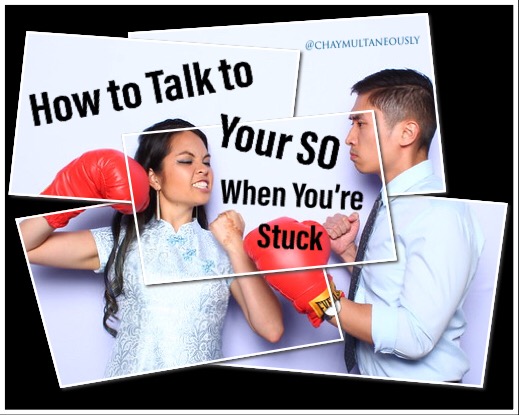How to Talk to Your SO When You're Stuck: Imago Dialogue, An Intro
New name, new post, new me!
Same old issues.
Relationships. They're so damn difficult.
As promised, I'm delivering the basics of the Imago Dialogue, the hard reboot to re-imaging your partner... not as easy as it sounds, but I know for a fact it's worth the effort.
Quoting straight from my textbook here:
"According to Imago Theory, the bottom line is this: Nature has put together two totally incompatible people--injured at the same place developmentally and missing opposite parts of themselves--in an effort to get their developmental needs met and to regain lost parts of themselves."
So how do you talk through something that never seems to be resolved?
1. Your baseline / Your "why" = Commitment
In any emotional change, this is important and seems like common sense, but if you aren't quite at the point of wanting or needing (or being able to afford) therapy, you want to make sure you're committed to the cause. (Not committed to like, marriage or even a relationship label, just committed to making a change.) Often when people come in to couples therapy, they would like their partner to be "fixed", or just the "problem" partner believes they need to change.
But, as much as we don't want to admit it, both people in a couple must commit to their own personal growth and understand how both of your vulnerabilities interact. So when I said "re-image" your partner earlier.. I meant, you have to do the work.. to change the image.. that you have.. of your partner. So yes, you are doing the work. And they are too.
 |
| When someone asks if we need personal growth |
2. Safety
Just like any science experiment or cooking venture or sports or physical exercise: safety first. Think of this as an emotional workout--it's gonna be difficult at first, maybe even awkward and definitely exhausting. And you're gonna have to practice again and again, so you don't want to get injured doing it!
3. Stretching
Now this is really starting to sound like a workout. Except when you workout, stretching is the easy part. In Imago therapy, stretching is actually the heavy lifting.
This is best done through example.
If you know me, one of my favorite movies is Indiana Jones and the Raiders of the Lost Ark. I knew Indy was meant for Marion; she is as tough as he is stubborn.
Indiana is a loner. He is the definition of the lone wolf, the 007 of the archeology world. He manages his life by doing and quick thinking; that's why we love him, right? No plans, never seems to see danger coming, but always has a way of thinking on his feet. The opposite of the loner (in Imago Theory) is the caretaker; Marion ran the bar and took care of her father. She fell for Indy, a man who never seemed to respond to her care.
Marion might ask Indy to recognize her when she's upset and notice out loud that he sees her; Indy might ask Marion to talk out how she's feeling and take action rather than fuming about an argument (and hopefully that action isn't to start flailing him with a frying pan). In this way, each partner has to try out the part of them that was muffled or repressed in childhood--the part that keeps them from being whole.
If you're able to have a safe space with your partner, I would try out asking each other to make one behavior change for a week, and make it specific to how many times a week; then reevaluate at the end to see what worked and what you can change. It could be the refresh you need to stop having the same argument/battle/war over and over again.
 |
| maybe he'll respond to this |
 |
| One more time couldn't hurt though. |
The main goal is this: you want to get to the point in your relationship when one person can express a need and the other person can work to meet that need, and vice versa.
The beauty of this brief scene where they finally stopped fighting wasn't just the romantic sensuality but the fact that Marion asks him "Well, where doesn't it hurt??" And he has the chance to actually say what he wants (sort of) and she responds with affection--which.. I think both of them really just need some TLC. ❤

 There are tons of couples therapy techniques for walking through those 3 steps, which is why I definitely want to cover how to find a therapist to help in the near future! But this is good for now. I want to say a quick thank you for reading.. I'm working on being consistent and helpful.. please message me or comment if you have questions or suggestions. I'm loving writing and getting my ideas out there.. it's a real treat to get these out every week so thank you for all of your support so far!!
There are tons of couples therapy techniques for walking through those 3 steps, which is why I definitely want to cover how to find a therapist to help in the near future! But this is good for now. I want to say a quick thank you for reading.. I'm working on being consistent and helpful.. please message me or comment if you have questions or suggestions. I'm loving writing and getting my ideas out there.. it's a real treat to get these out every week so thank you for all of your support so far!!










UNAGI!! xoxo Also, love this article! Very helpful and fun voice to read :)
ReplyDeleteI appreciate this so much.. thank you!! 😭
DeleteKeep sharing such posts. Trauma resolution therapy center in San Digeo offers premarital therapy and marriage counseling in San Diego for couples to better understand the dynamics of a relationship and support healing and growth.
ReplyDeleteIMAGO RELATIONSHIP therapy San Diego
Couples therapy is a type of counseling where a therapist works with couples to help them solve problems and improve their relationships. It can be expensive, but there are many low cost couples therapy options.
ReplyDeletelow cost couples therapy
Low-cost couples therapy can be found in community centers, religious organizations, and online resources. Some people may not know about these resources and may be stuck paying for high-priced sessions.
Therapists assist a couple in choosing a challenging event from recent history and having them reenact it while pausing at the points when they might or might have acted differently. Couples therapy Cincinnati
ReplyDelete